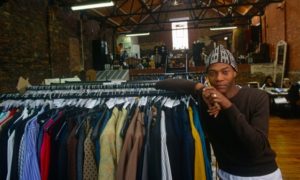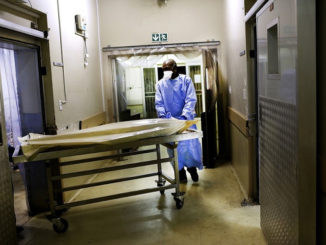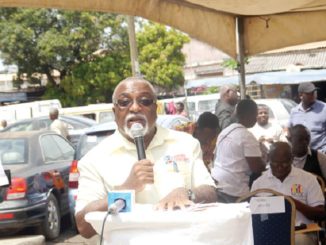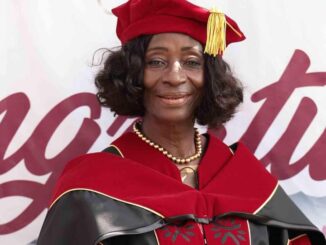His suits were worn by Bono and Gordon Brown; he was the first serious name to collaborate with Topshop, in 1993; and the first to make mini-ranges for middle Britain’s redoubt, John Lewis. He adored the anarchic power of punk (its politics, not its binbags) and as creative director of the arch-Savile Row firm Gieves & Hawkes (2005-08) took it to the Paris catwalk. Mixing it: that was life and the future.
His father, Victor Casely-Hayford, a barrister from Ghana , had settled in the UK and he and his wife, Ransolina, expected much from Joe and his siblings, Gus, Peter and Margaret. Joe was not particularly academic and did not feel he belonged, “so that made me interested in the cult of the individual. I wanted to create my own identity and that’s what drew me into fashion”. The rebellion was to cut his own gear from second hand tat and wear Manolo Blahnik women’s shoes.
Joe Casely-Hayford, left, with his son and business partner, Charlie, on the catwalk of the Casely-Hayford show at London Fashion Week in 2017. Photograph: WWD/Rex/Shutterstock Yet his higher education was as thorough as the family could have wished: the workshop of Doug Hayward , favourite of celebrities and workng-class dandies; the Tailor and Cutter Academy; and then fashion design at St Martin’s School of Art, followed by history of art at the ICA. He knew how to set a sleeve head well before he met a theory.
The London fashion business was still informal in the 1980s, with low rents, low volume and a let’s-make-it-right-here-on-the-kitchen-table attitude. Casely-Hayford’s first brand, KIT, was just what it said on the label – army surplus canvas tents bought mouldering from a Bankside warehouse, bleached, distressed and cut up into garments.
That they were found in the Clink, SE1, mattered, because the cacophony of London always fed Casely-Hayford’s creativity. He knew the East End best, because West End fashion had historically outsourced hand-finishing east to Whitechapel, so when he took cheap workspace in 1984 to design for his new Joe Casely-Hayford label, it was in Brick Lane, where inspiration walked past his door, “mixing English-gentleman pieces with their religious clothing” on the way to the mosque. Surplus supplies were dwindling, so he was among the earliest designers to look for quality piece goods still being millwoven in the UK, and from these he made his first collection.
The tailoring was old-school Savile Row, but the ideas were global, with sartorial jokes including shirts that buttoned back and front. Casely-Hayford stayed faithful to the East End, moving the studio to Shoreditch, and then tracking undeveloped zones up as far as Seven Sisters.
He had to expand, because everybody wanted his output or intervention. Before he even had a studio, he had styled for Island Records and the Clash came calling; U2 followed, as did Take That, Liam Gallagher, Lou Reed and Jarvis Cocker. He was on call 24/7 through the 80s and 90s for stage costumes and wedding suits, and also worked for magazines: “When I saw the first issue of i-D, I saw people who were outsiders and that gave me hope in a socio-political sense. Prior to that, black people did ‘black things’.”
He showed in Paris and Tokyo, sold in New York, and set up a 1995 Barbican Art Gallery exhibition on African textiles. Before that, he had not consciously brought Africa much into his work, but its fabrics had become as local to Kingsland Road, Hackney, as a Greggs bakery, so it joined the mix.
The label, which also produced womenswear, ran until 2005, when Casely-Hayford was recruited by Gieves & Hawkes to see if a heritage tailoring establishment could be modernised as couture houses had been. This meant questioning every pad and stitch and he transferred all that R&D over in 2009 into a new brand, its label, Casely-Hayford, standing for his work and that of his son and business partner, Charlie.
They survived in the relentless clothing industry (more collections, volume and hype) by careful withdrawal, sometimes designing on the way to Japan, where they cultivated factories sympathetic to their English style, defined by Casely-Hayford Sr as “country estates and housing estates”. Besides selling in the usual grand international venues, father and son opened a small, kindly shop in Marylebone.
Casely-Hayford said that through his children (his daughter Alice works for British Vogue) he saw “you can be where you want to be now. Thirty years ago we were fighting for our self-expression … it was very difficult to operate outside those parameters.”
He was appointed OBE in 2007.
His wife, Maria Stevens, whom he met at St Martin’s and married in 1980, survives him, as do their children, Charlie and Alice, and his siblings.
• Joseph Ephraim Casely-Hayford, tailor and designer, born 24 May 1956; died 3 January 2019
–
theguardian.com




